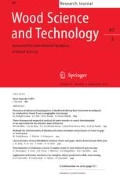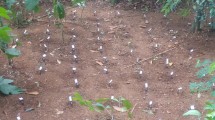Abstract
Laboratory choice and no-choice tests following the guidelines of EN 117 (2013) were performed to assess the resistance of wood modified with short- and long-chain amino-functional siloxane emulsions to subterranean termites (Reticulitermes flavipes). Scots pine sapwood was vacuum-pressure treated to reach 2, 5 and 8 % weight percent gain. Half of the specimens (including controls) were subjected to an accelerated aging test according to the standard EN 84 (1997) prior to termite testing. In addition to visual rating, mass losses were also determined. In case of the no-choice test, silicone-treated samples were not resistant according to EN 117 (2013), even though a clear reduction in mass loss had occurred. After exposure to a choice test, the modified wood samples showed 5–10 times less mass loss than control samples, even in the case of the leached specimens. This study reveals a good performance of wood modified with short-chained amino-functional siloxanes in resisting to R. flavipes when there is a choice of feeding.
Similar content being viewed by others
References
Austin JW, Szalanski AL, Uva P, Bagnères AG, Kence A (2002) A comparative genetic analysis of the subterranean termite genus Reticulitermes (Isoptera: Rhinotermitidae). Ann Entomol Soc Am 95:753–760
Austin JW, Szalanski AL, Scheffrahn RH, Messenger MT, Dronnet S, Bagnères AG (2005a) Genetic evidence for the synonymy of two Reticulitermes species: Reticulitermes flavipes (Kollar) and Reticulitermes santonensis (Feytaud). Ann Entomol Soc Am 98:395–401
Austin JW, Szalanski AL, Scheffrahn RH, Messenger MT (2005b) Genetic variation of Reticulitermes flavipes (Isoptera: Rhinotermitidae) in North America applying the mitochondrial rRNA 16S gene. Ann Entomol Soc Am 98:980–988
Clément JL, Bagnères AG, Uva P, Wilfert L, Quintana A, Reinhard J, Dronnet S (2001) Biosystematics of Reticulitermes termites in Europe: morphological, chemical and molecular data. Insectes Soc 48:202–215
Donath S, Militz H, Mai C (2004) Wood modification with alkoxysilanes. Wood Sci Technol 38:555–566
Donath S, Militz H, Mai C (2006) Treatment of wood with aminofunctional silanes for protection against wood destroying fungi. Holzforschung 60:210–216
EN 84 (1997) Wood preservatives. Accelerated ageing of treated prior to biological testing. Leaching procedure (Foreign Standard)
EN 117 (2013) Wood preservatives. Determination of toxic values against Reticulitermes Species (European termites) (Laboratory method)
EN 350 (2013) (prEN 350) Durability of wood and wood-based products. Testing and classification of the resistance to biological agents, the permeability to water and the performance of wood and wood-based materials
Feci E, Nunes L, Palanti S, Duarte S, Predieri G, Vignali F (2009) Effectiveness of sol-gel treatments coupled with copper and boron against subterranean termites. IRG/WP/30493. The International Research Group on Wood Protection, Stockholm
Furuno T, Imamura Y (1998) Combinations of wood and silicate Part 6. Biological resistances of wood-mineral composites using water glass-boron compound system. Wood Sci Technol 32:161–170
Gascón-Garrido P, Oliver-Villanueva JV, Ibiza-Palacios MS, Militz H, Mai C, Adamopoulos S (2013) Resistance of wood modified with different technologies against Mediterranean termites (Reticulitermes spp.). Int Biodeterior Biodegrad 82:13–16
Geshini S, Messenger MT, Pilon N, Marini M (2010) First report of Reticulitermes flavipes (Isoptera: Rhinotermitidae) in Italy. Fla Entomol 93:327–328
Geshini S, Pilon N, Marini M (2011) A new finding of Reticulitermes flavipes in northern Italy. Bull Insectol 64:83–84
Ghosh SC, Peters BC, Fitzgerald CJ, Militz H, Mai C (2012a) Resistance of Scots pine (Pinus sylvestris L.) wood modified with functionalized commercial silicone emulsions against subterranean termites. Wood Sci Technol 46:1033–1041
Ghosh S, Dyckmans J, Militz H, Mai C (2012b) Effect of quat- and amino-silicones on fungal colonization and decay of wood. Holzforschung 66:1009–1015
Hadi YS, Westin M, Rasyid E (2005) Resistance of furfurylated wood to termite attack. For Prod J 55:85–92
Hager R (1995) Waterbone silicones as wood preservatives. IRG/WP/30062. The International Research Group on Wood Preservation, Stockholm
Hertel H, Plarre R (2004) Termites in Hamburg. In: Proceedings of the COST action E22 Final workshop, Estoril
Hill CAS (2006) Wood modification: chemical, thermal and other processes. Wiley, Chichester
Hwang WJ, Kartal SN, Shinoda K, Imamura Y (2005) Surface treatment for preventing decay and termite attack in wood using didecyl dimethyl ammonium tetrafluoroborate (DBF) incorporated with acryl-silicon type resin. Eur J Wood Prod 63:204–208
Ibach RE, Hadi YS, Nandika D, Yusuf S, Indrayani Y (2000) Termite and fungal resistance in situ polymerized tributyltin acrylate and acetylated Indonesian and USA Wood. IRG/WP/30219. The International Research Group on Wood Preservation, Stockholm
Imamura Y, Nishimoto K (1986) Resistance of acetylated wood to attack by subterranean termites. Wood Res Kyoto 72:37–44
Kartal SN, Yoshimura T, Imamura Y (2008) Modification of wood with Si and B compounds. In: Proceedings of the International Conference on Durability of Building Materials and Components, Istanbul
Kartal SN, Yoshimura T, Imamura Y (2009) Modification of wood with Si compounds to limit boron leaching from treated wood and to increase termite and decay resistance. Int Biodeterior Biodegrad 63:187–190
Lande S, Schneider M, Westin M, Phillips J (2006) Furfurylated wood: an alternative to preservatives. In: Proceedings of the wood protection conference. Forest Products Society, Madison, WI
Lukowsky D, Peek RD, Rapp AO (1997) Water-based silicones on wood. IRG/WP/30144. The International Research Group on Wood Preservation, Stockholm
Mai C, Militz H (2004) Modification of wood with silicon compounds. Treatment systems based on organic silicon compounds—a review. Wood Sci Technol 37:453–461
Mai C, Donath S, Militz H (2003) Modification of wood with silicon compounds. In: Van Acker J, Hill C (eds) Proceedings of the first European conference on wood modification, Ghent, pp 239–251
Mayer H (1998) Masonry protection with silanes, siloxanes and silicone resins. JOCCA Surf Coat Int 81:89–93
McKern JA, Szalanski AL, Austin JW (2006) First record of Reticulitermes flavipes and Reticulitermes hageni in Oregon (Isoptera: Rhinotermitidae). Fla Entomol 89:541–542
Militz H, Peters BC, Fitzgerald CJ (2009) Termite resistance of some modified wood species. IRG/WP/40449. The International Research Group on Wood Protection, Stockholm
Militz H, Schaffert S, Peters BC, Fitzgerald CJ (2011) Termite resistance of DMDHEU-treated wood. Wood Sci Technol 45:547–557
Oliver-Villanueva JV, Gascón-Garrido P, Ibiza-Palacios MS (2013) Evaluation of thermally-treated wood of beech (Fagus sylvatica L.) and ash (Fraxinus excelsior L.) against Mediterranean termites (Reticulitermes spp.). Eur J Wood Prod 71:391–393
Preston AF (2000) Wood preservation: trends of today that will influence the industry tomorrow. For Prod J 50:13–19
Pries M, Wagner R, Kaesler KH, Militz H, Mai C (2012) Effect of short-chain silicones bearing different functional groups on the resistance of pine (Pinus sylvestris L.) and beech (Fagus sylvatica L.) against decay fungi. Holzforschung 67:447–454
Ragon KW, Nicholas DD, Schultz TP (2008) Termite-resistant heartwood: the effect of the non-biocidal antioxidant properties of the extractives (Isoptera: Rhinotermitidae). Sociobiology 52:47–54
Scholz G, Militz H, Gascón-Garrido P, Ibiza-Palacios MS, Oliver-Villanueva JV, Peters BC, Fitzgerald CJ (2010) Improved termite resistance of wood by wax impregnation. Int Biodeterior Biodegrad 64:688–693
Schultz TP, Nicholas DD, Preston A (2007) A brief review of the past, present and future of wood preservation. Pest Manag Sci 63:784–788
Weidner VH (1937) Termiten in Hamburg. Z Pflanzenk Pflanzenschutz 47:593–596
Weigenand O, Humar M, Daniel G, Militz H, Mai C (2008) Decay resistance of wood treated with amino-silicone compounds. Holzforschung 62:112–118
Westin M, Rapp AO, Nilsson T (2004) Durability of pine modified by 9 different methods. IRG/WP/40288. The International Research Group on Wood Protection, Stockholm
Yamaguchi H (2003) Silicic acid: boric acid complexes as wood preservatives. Ability of treated wood to resist termites and combustion. Wood Sci Technol 37:287–297
Acknowledgments
We would like to thank Momentive Performance Materials Silicones B. V. for financial support.
Author information
Authors and Affiliations
Corresponding author
Rights and permissions
About this article
Cite this article
Gascón-Garrido, P., Thévenon, M.F., Militz, H. et al. Resistance of Scots pine (Pinus sylvestris L.) modified with short- and long-chain siloxanes to subterranean termites (Reticulitermes flavipes). Wood Sci Technol 49, 177–187 (2015). https://doi.org/10.1007/s00226-014-0688-2
Received:
Published:
Issue Date:
DOI: https://doi.org/10.1007/s00226-014-0688-2




